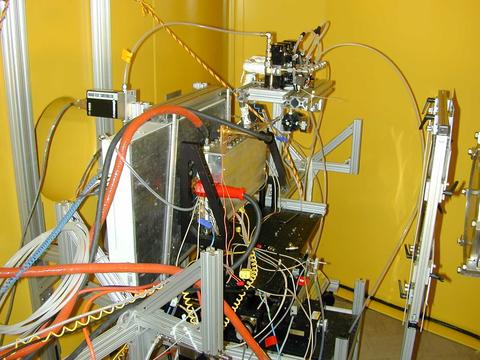Summary
In October 2020 the Department of Energy (DOE) created a new laboratory consortium with a mission to “advance the efficiency and durability of proton exchange membrane fuel cells at a pre-competitive level to enable their commercialization for heavy-duty vehicle applications”. The NIST Neutron Imaging Team contributes to the Component Integration thrust portion of this consortium to image and study proton exchange membrane fuel cells (PEMFCs).
Description

Figure 1: Installation of an automotive fuel cell test section at the NIST neutron imaging facility.
True in operando imaging of PEMFCs to observe and quantify water transport phenomena is only possible with neutrons. NIST, in partnership with General Motors and support of the EERE has developed a world-class facility for in operando neutron imaging of fuel cells for light duty vehicles. Upgrades to the hydrogen infrastructure will enable imaging the full active area of single to 5 cell stacks that will compose a heavy duty fuel cell engine. For fundamental materials characterization, we will develop a test section that enables simultaneous neutron and X-ray tomography (NeXT) for which NIST earned an R&D100 award in 2018. 3D neutron imaging during transient operation has not been possible due to inherent flux limitations. NIST is developing a novel neutron microscope that will provide 3 µm spatial resolution with time resolution of about 1 s, which will enable real-time 3D imaging.
Facility Infrastructure and Equipment available to all users:
- Hydrogen infrastructure
- Hydrogen generator
- Production up to 18.8 lpm
- Small scale fuel cell test stand, Micro
- Load: Agilent N3300 Series load with (2) N3306A modules, 0-240 A, 0-60 V
- 3.3 V boost supply for low voltage operation
- Electric cell heater temperature control with ability to independently control anode and cathode temperatures
- Anode gas control: 50, 500, 3000 sccm H2, 2000 sccm N2
- Cathode gas control: 50, 500, 2000, 8000 sccm air/N2, 500, 2000 sccm O2, oxygen - nitrogen blends can be produced on the fly
- Absolute pressure transducers on outlet, pressure control via inlet or outlet
- 400 kPa exhaust pressure
- Gamry reference 3000 potentiostat
- Large scale fuel cell test stand, Greenlight Innovation G200
- Load: dual range operation (10%/100%). Maximum: 5KW, 10V, 1500A, max. current available down to 0.0V
- Liquid coolant for stack (using heavy water)
- Electric end cell heaters, 1200 W per side
- Contact humidifiers 35°C to 120°C dewpoint, with a bypass
- Anode flow 1-80 NLPM max (blending H2 and N2)
- Cathode flow 1-200 NLPM max (blending air and N2)
- Pressure control, 0 – 300 kPag
- Cell voltage monitor to measure each cell
- Double 4/0 electrical cables with 3/8 inch bolt lugs to each cell terminal
- Swagelok compression fittings on hoses: Anode Inlet/Outlet 3/8” / 1/2”, Cathode Inlet/Outlet 1/2" / 3/4", Coolant 1/2".
- Hydrogen generator

